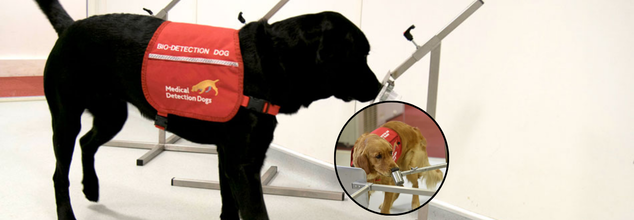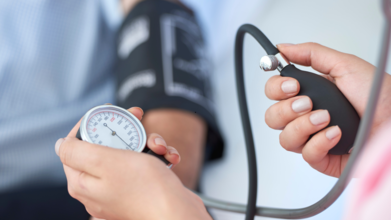- Health Conditions A-Z
- Health & Wellness
- Nutrition
- Fitness
- Health News
- Ayurveda
- Videos
- Medicine A-Z
- Parenting
- Web Stories
Forget Blood Tests Now Dogs Can Sniff Out Parkinson’s Before Symptoms Appear

Credits: Medical Detection Dogs UK
Parkinson’s disease is notoriously difficult to diagnose early. Most patients aren’t identified until visible motor symptoms—tremors, stiffness, and slowness—are already affecting their lives. By that point, neurodegeneration has usually been ongoing for years. But a new study out of the UK could be a game-changer: specially trained dogs have proven they can detect Parkinson’s disease with remarkable accuracy—just by sniffing skin swabs.
In controlled clinical trials, two dogs achieved sensitivities between 70–80% and specificities exceeding 90% in detecting Parkinson’s disease from the scent of sebum, an oily substance secreted by the skin. That’s not just impressive—it rivals many of today’s most advanced diagnostic tools.
Does Parkinson’s Has a Scent?
What exactly are dogs smelling? Turns out, Parkinson’s isn’t just a neurological disease. It also affects how the body metabolizes and produces oils on the skin. These changes lead to a unique profile of volatile organic compounds (VOCs)—essentially odor molecules—that trained dogs can detect.
The research builds on previous anecdotal reports, including that of Joy Milne, a Scottish woman who famously detected a musky scent from her husband years before he was diagnosed with Parkinson’s. Scientists later confirmed that this scent wasn’t imaginary—it was chemically real. Dogs, with their 10,000x more sensitive noses, just happen to be better equipped than humans at picking it up.
How The Dogs Were Trained?
Researchers at the Universities of Bristol and Manchester collaborated with Medical Detection Dogs, a UK-based charity, to test whether Parkinson’s has a detectable odor signature. They began with 10 dogs and narrowed it down to two standouts: a male Golden Retriever and a Labrador-Golden mix.
Over the course of 38 to 53 weeks, these dogs were trained using 205 cotton swab samples collected from patients' backs—some with Parkinson’s, others without. Dogs were rewarded when they correctly identified samples from individuals with the disease. Importantly, the study was double-blind: neither the trainers nor the researchers knew which swabs were which during testing, ensuring unbiased results.
When the final test arrived—100 brand-new samples the dogs had never sniffed before—the animals performed exceptionally well. One dog hit 70% sensitivity and 90% specificity, while the other clocked in at 80% sensitivity and an astounding 98% specificity.
For context, that level of performance is on par with several existing diagnostic tests and better than previous scent-based trials involving cancers or infections.
Currently, there’s no blood test or brain scan that definitively diagnoses Parkinson’s early. Clinicians rely on watching for physical symptoms, which means by the time you’re diagnosed, significant damage may have already occurred.
Detection dogs could change that. By identifying Parkinson’s via skin swabs—before symptoms show up—these animals could help start the treatment process earlier, potentially slowing disease progression or improving long-term outcomes.
It’s especially meaningful in rural or underserved areas, where neurologists and movement disorder specialists are harder to access. A non-invasive, rapid screening tool—even if it’s a dog—could fill critical gaps.
Parkinson’s patients often develop seborrheic dermatitis, a condition that increases the production of sebum. In those with Parkinson’s, this sebum is chemically different. Dogs can detect those changes.
This builds on previous studies which have shown that diseases like cancer, malaria, and even COVID-19 can subtly change the body’s scent signature. The nose—particularly a canine one—may be among the most overlooked diagnostic tools in medicine.
And while dogs won’t be showing up in every clinic just yet, the data they provide is already helping researchers design electronic noses—devices that mimic canine olfaction and can detect VOCs in human sweat, sebum, or breath.
Are There Any Limitations Of This Kind Of Detection?
Of course, the idea of using dogs as diagnostic tools has its limits. Training a single dog takes nearly a year and is resource-intensive. Only a small number of dogs are temperamentally suited to this kind of highly focused scent work. And the study still doesn’t explain why some Parkinson’s patients’ samples were easier for dogs to detect than others.
Researchers also emphasize that dogs would not replace neurologists—but they could be used as a pre-screening tool, flagging individuals who should undergo further clinical evaluation.
The dogs in this study worked only with drug-naive patients—those who hadn’t yet started medications—meaning the scent signature they detected wasn’t masked or altered by pharmaceutical treatment. Future research may explore whether medication changes a patient’s odor profile or affects detection accuracy.
How Will This Change the Future of Parkinson’s Diagnosis?
Quite possibly, if scientists can isolate the exact VOCs that signal Parkinson’s—and replicate what dogs detect with sensors or lab tests—we could one day have a rapid, affordable, and non-invasive way to diagnose the disease long before traditional symptoms show up.
That would mark a sea change in Parkinson’s treatment strategy: from managing symptoms to preemptively addressing the disease at its earliest, most treatable stage.
Until then, we may just need to trust our four-legged friends to lead the way—nose first.
Dogs are proving to be more than just loyal companions—they’re potentially medical detectives. With their powerful noses, they may soon help detect Parkinson’s earlier than ever before, offering hope for millions living with or at risk of the disease.
WHO Adds GLP-1 Drugs And Cancer Therapies To Updated Essential Medicines List For First Time In 2025

Credits: Canva
The World Health Organization (WHO) has, for the first time, added GLP-1 receptor agonists, popularly known as the active ingredients behind weight loss drugs like Ozempic and Wegovy to its Essential Medicines List (EML). The move, announced Friday, marks a turning point in the global conversation about diabetes, obesity, and equitable access to life-saving treatments.
The Essential Medicines List is one of WHO’s most influential public health tools. Updated every two years, the list identifies medicines that should be available in every functioning health system, regardless of a country’s income level. It now includes 523 medicines for adults and 374 for children. Adoption is widespread: over 150 countries use the EML as a reference point for drug procurement, health insurance coverage, and treatment guidelines.
By including GLP-1 receptor agonists such as semaglutide (Ozempic, Wegovy), liraglutide, and tirzepatide (Mounjaro), WHO has formally acknowledged their role not just in diabetes management but also in broader health outcomes, particularly cardiovascular and kidney health.
Also Read: World Physiotherapy Day 2025: Themes, Significance And History
Why the Addition of GLP-1 Drugs is Revolutionary?
GLP-1 receptor agonists mimic a natural hormone that regulates blood sugar and appetite. They stimulate the pancreas to release insulin, slow digestion, reduce liver glucose production, and act on the brain to suppress hunger. This dual benefit—controlling diabetes and supporting weight loss—has propelled them into mainstream awareness.
Scientific evidence reviewed by WHO’s Expert Committee confirmed their ability to lower blood sugar, reduce risks of heart and kidney complications, support weight management, and even extend life expectancy in people with type 2 diabetes and related conditions. For patients with cardiovascular disease, kidney disease, or obesity, these drugs are emerging as game-changers.
The Limits of the Decision
It’s important to note that while GLP-1s are popularly associated with weight loss, WHO stopped short of endorsing them for obesity alone. The drugs were added specifically for adults with type 2 diabetes mellitus who also have established cardiovascular disease, chronic kidney disease, or obesity.
This distinction matters. While obesity affects over one billion people worldwide, WHO’s cautious stance reflects the still-limited long-term data on safety, sustainability of weight loss, and cost-effectiveness in populations without diabetes.
Barriers to Access
Affordability remains the biggest hurdle. Médecins Sans Frontières (MSF) called the decision a “critical milestone” but highlighted that in low-resource settings, GLP-1s are practically out of reach.
A recent MSF study found GLP-1 agonists can cost up to 400 times more than their estimated manufacturing price, while rapid-acting insulin analogues also newly included on the list—are priced 75 times higher than what they could be profitably produced for.
Also Read: Blood Pressure Guidelines Get An Update After 8 Years, Here's All That You Need To Know
“Rapid-acting insulins and GLP-1s are unaffordable and often unavailable in low-resource and humanitarian settings,” said Elizabeth Jarman of MSF’s Access Campaign. “Countries must act quickly to update national EMLs, plan procurement, and push pharmaceutical corporations to make them affordable.”
WHO echoed this call, urging governments to prioritize patients who would benefit most, support generic competition to drive prices down, and ensure distribution at the primary care level, especially in underserved areas.
Expanding the Scope Cancer Treatment
The 2025 update of the EML goes far beyond GLP-1s. Twenty new medicines were added for adults, alongside 15 for children. Notable inclusions are:
Cancer Immunotherapies: Pembrolizumab (Keytruda) and alternatives atezolizumab and cemiplimab for metastatic cervical, colorectal, and non-small cell lung cancers. These immune checkpoint inhibitors have been shown to prolong survival by four to six months in advanced cancers.
Cystic Fibrosis Therapy: Trikafta (a triple-combination drug by Vertex Pharmaceuticals) was hailed as a “historic breakthrough” by patient advocacy groups, marking the first time a cystic fibrosis-specific therapy made the EML.
Insulin Expansion: Short-acting insulin analogues were added, complementing the long-acting formulas already listed since 2021. This creates a complete set of recommended insulin therapies, critical for tailoring diabetes treatment.
Vaccines and Pediatric Medicines: The children’s list now includes drugs for haemophilia, cystic fibrosis, and newly approved vaccines for malaria and mpox.
Tensions Over Excluded Drugs
Not all proposals made it onto the list. Knowledge Ecology International criticized WHO for excluding risdiplam, a treatment for spinal muscular atrophy (SMA). The drug, they argued, is effective, relatively inexpensive to manufacture, and could transform outcomes for children with SMA.
WHO’s Expert Committee deferred inclusion due to incomplete trial data, though subsequent studies published later in the year showed highly promising results.
How Does The Updated Essential Medicine List Affect Global Health?
The stakes of WHO’s decision are high. Diabetes and obesity are among the most pressing health challenges worldwide. More than 800 million people are living with diabetes, half without treatment, while obesity affects over a billion. These conditions are not confined to wealthy nations; their fastest growth is occurring in low- and middle-income countries.
Including GLP-1s in the Essential Medicines List sends a strong signal to governments, insurers, and pharmaceutical companies: these drugs are not luxury treatments for the wealthy but part of the global standard of care.
Yet the path from inclusion to access is not straightforward. Countries must adopt the drugs into their national lists, negotiate prices, and strengthen health systems to deliver them effectively. As David Reddy, director-general of the International Federation of Pharmaceutical Manufacturers, pointed out, inclusion on the list must be accompanied by infrastructure, diagnostics, and trained professionals.
Cancer treatments remain one of the most tightly scrutinized areas of the EML. Cancer kills nearly 10 million people each year, accounting for one in three premature deaths from non-communicable diseases. Despite the flood of new cancer drug approvals in recent years, WHO only recommends therapies that demonstrate clear survival benefits of at least four to six months.
The inclusion of pembrolizumab and its alternatives reflects both clinical evidence and a deliberate effort to reduce global inequities in cancer care. Still, the high cost of immunotherapies poses a major barrier. Without mechanisms like tiered pricing and voluntary licensing, poorer countries may struggle to make these life-extending drugs widely available.
The 2025 Essential Medicines List reflects both optimism and realism. On one hand, it celebrates remarkable advances in science—from GLP-1s reshaping diabetes care to breakthrough therapies for cystic fibrosis and cancer. On the other, it acknowledges the sobering reality of cost and access.
World Physiotherapy Day 2025: Themes, Significance And History

Credits: Canva
Every year on September 8, World Physiotherapy Day, a global healthcare event is observed. The practice started in 1996, commemorating the date of the World Physiotherapy foundation in 1951. After major surgeries, patients are recommended physiotherapy to help them with movements, this is why a separate day is designated for a therapy that gets the patients back on their feet, doing things like they did before.
The aim of physiotherapy is to achieve a symptom-free movement at basic to complex physical activities.
World Physiotherapy Day 2025 Theme
This year in 2025, the theme for World Physiotherapy Day is 'Healthy Ageing', with a special focus on preventing frailty and falls. The theme emphasizes the significance of exercise and physical therapy for encouraging healthy aging. It also focuses on lowering frailty and preventing falls in older person, which comes with a good posture and balance, possible through regular exercises.
As the world's population ages, maintaining mobility, independence, and high standard of living becomes a public health concern. However, regular exercise could help the elderly with mobility, and thus physiotherapy interventions become a necessity.
In 2024, the theme was Low back pain or LBP and the role of physiotherapy in its management and prevention.
The Significance of World Physiotherapy Day
Everyone values the ability to live as independently as possible in their daily lives. When injuries, illnesses, or health conditions affect movement, many people, from patients to fitness enthusiasts, turn to physical therapy. The goal is simple: to regain the ability to perform the activities that matter most to them.
Among the many approaches used in healthcare, therapeutic exercise stands out as a core component. It plays a central role in programs designed to restore function, enhance performance, and even prevent future problems.
Physical function is multidimensional, involving several interconnected areas. A well-designed therapeutic exercise plan may focus on:
- Improving balance
- Building cardiopulmonary endurance
- Developing coordination
- Increasing flexibility
- Enhancing mobility
- Strengthening muscle performance
- Boosting neuromuscular control
- Supporting postural control and stability
- Maintaining overall equilibrium
Together, these elements work to help individuals move better, feel stronger, and live more confidently.
ALSO READ: How To Recover From Sports Injuries Faster With Targeted Physiotherapy
Here Is The History Of World Physiotherapy Day
World Physiotherapy Day is observed every year on September 8, a date chosen in 1996 by the global organization World Physiotherapy. The organization itself was founded on September 8, 1951, in the United Kingdom and today represents over 600,000 physiotherapists worldwide, bringing together 127 member organizations.
ALSO READ: Debunking Common Myths About Physiotherapy
World Physiotherapy works to promote safe working conditions for physiotherapists and advocates for evidence-based practices that make quality physiotherapy care accessible and affordable for all.
India has been part of this global community since 1967, with various Indian physiotherapy associations and professionals actively represented in World Physiotherapy.
Blood Pressure Guidelines Get An Update After 8 Years, Here's All That You Need To Know

Credits: Canva
The American Heart Association (AHA) and the American College of Cardiology (ACC) have just released their first major update to blood pressure management guidelines since 2017. These new recommendations go beyond simply telling you what numbers to aim for, they focus on prevention, early intervention, and more personalized care across your entire lifespan.
High blood pressure (hypertension) is one of the biggest risk factors for heart disease, the world’s leading cause of death, as well as kidney disease, stroke, type 2 diabetes, and even dementia. With nearly half of all U.S. adults having higher-than-normal blood pressure, these new guidelines are significant for millions of people.
Blood Pressure Targets Remain the Same
One thing that hasn’t changed in 8 years, is how high blood pressure is defined. The cutoff points are still the same as they were in 2017:
- Normal: Less than 120/80 mm Hg
- Elevated: 120–129 mm Hg systolic and under 80 mm Hg diastolic
- Stage 1 Hypertension: 130–139 mm Hg systolic or 80–89 mm Hg diastolic
- Stage 2 Hypertension: 140 mm Hg or higher systolic, or 90 mm Hg or higher diastolic
Your blood pressure reading has two numbers:
The top number (systolic) measures the pressure when your heart pumps, while the bottom number (diastolic) measures it when your heart is at rest.
More Aggressive Early Intervention
While the numbers haven’t changed, how doctors treat them has. The new guidelines recommend starting with healthy lifestyle changes, like eating better, exercising, and reducing salt, for anyone with readings in the 130–139 range. If those changes don’t work after three to six months, medication may be prescribed earlier than before.
This shift is meant to prevent complications before they start. “We’re aiming to help more people get their blood pressure under control earlier to prevent heart disease, strokes, kidney problems, and even dementia,” said Dr. Daniel W. Jones, chair of the writing committee for the new guidelines.
ALSO READ: The 'Three S' That Are Worsening Your Blood Pressure Levels
A Bigger Focus on Weight Loss and GLP-1 Medications
One of the most notable updates involves the use of GLP-1 receptor agonists, such as Ozempic and Mounjaro, which have become popular for weight loss. The guidelines now say that patients who have high blood pressure and are overweight should discuss these medications with their healthcare provider, as losing weight can dramatically improve blood pressure control.
For people with severe obesity, surgery may even be recommended if lifestyle changes and medications are not enough.
New Pregnancy and Postpartum Recommendations
High blood pressure during pregnancy can be dangerous, leading to complications such as preeclampsia, which can threaten both the parent and baby. The new guidelines recommend that pregnant and postpartum individuals with stage 2 hypertension start on certain medications to lower the risk of complications. This is an important shift, as research shows pregnancy-related hypertension can have lasting effects on cardiovascular health.
Also Read: Russian Cancer Vaccine Enteromix Could Prevent Colon Cancer, Details Inside
The Brain Connection: Dementia Risk
Another significant addition to the 2025 guidelines is the acknowledgment of the link between high blood pressure and cognitive decline. New research shows that hypertension can reduce blood flow to the brain, leading to memory issues and an increased risk of dementia. By controlling blood pressure early, the hope is to preserve cognitive function later in life.
The PREVENT Risk Calculator
Doctors are now encouraged to use a new tool, called PREVENT, to estimate a patient’s risk of developing heart disease over the next 10 and 30 years. This calculator considers multiple factors: age, sex, cholesterol levels, blood pressure, and more, to create a personalized risk profile and guide treatment decisions.
Alcohol Guidance Tightened
In a change that may surprise many, the updated guidelines now recommend avoiding alcohol entirely if possible. Previous advice allowed for one drink per day for women and two for men, but growing evidence shows even moderate alcohol intake can raise blood pressure. For those who still choose to drink, the AHA now advises staying under those older limits.
Lifestyle Changes Are Still the Foundation
Despite all the new tools and treatments, the cornerstone of blood pressure management remains the same: a healthy lifestyle. The updated recommendations reinforce:
- Following a heart-healthy diet like the DASH plan, rich in fruits, vegetables, whole grains, lean proteins, beans, and nuts
- Reducing sodium intake to less than 2,300 mg per day, ideally aiming for 1,500 mg
- Exercising regularly, with at least 150 minutes of moderate activity weekly plus resistance training
- Managing stress through mindfulness, yoga, or relaxation techniques
- Maintaining a healthy weight, losing at least 5% of body weight if overweight
Why This Matters
High blood pressure is often called the “silent killer” because it has no symptoms but can do significant damage over time. By encouraging earlier treatment, recognizing new links to conditions like dementia, and providing tools like the PREVENT calculator, the 2025 guidelines aim to help people live longer, healthier lives.
“The reality is that the first line of treatment, lifestyle changes, really does work if you commit to it,” Dr. Jones said. “It can be hard in today’s food environment, but the payoff is worth it.”
© 2024 Bennett, Coleman & Company Limited

